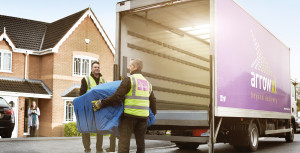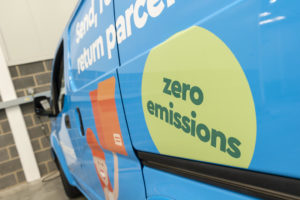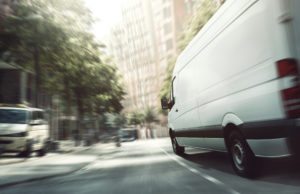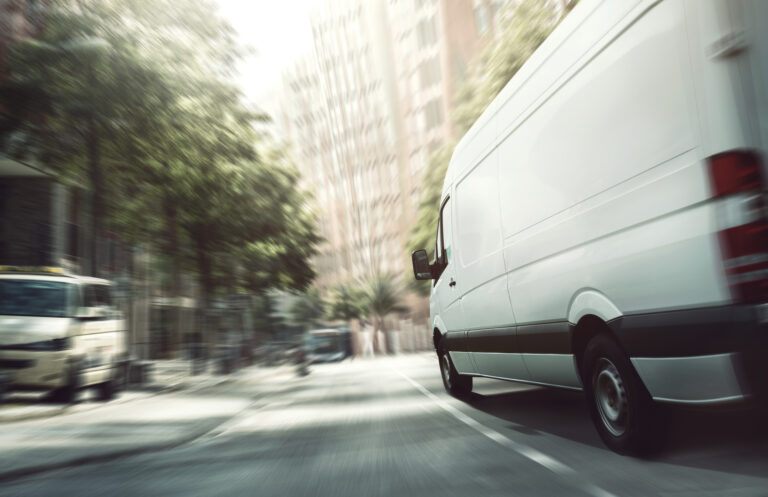Retailers are always looking to make home deliveries easier, faster and greener in the face of the growing e-commerce market and environmentally-savvy consumers. But can you keep the balance between being green and keeping an expanding customer base happy? Maria Highland investigates.
There is no doubt that the way we shop has changed in recent years. Next-day delivery is now a common occurrence as we shop on our smartphones at all hours of the day. This has had a knock-on effect on the supply chain, particularly retailers and delivery companies as they strive to cater to increasingly more demanding consumer expectations.
“Consumers are used to ordering online, 24/7, from smartphones while on the move and don’t see any reason for deliveries to be limited to 9-5 Monday to Friday. They expect highly flexible and responsive deliveries. They want deliveries on Saturdays, Sundays, early mornings, evenings,” says Panther Warehousing chief executive Colin McCarthy. “The Amazon generation wants to fit deliveries around their busy lives – not to fit that of the retailer or the carrier.”
Indeed, the e-commerce boom has “fundamentally changed how consumers make purchases, empowering shoppers to purchase what they want, when they want,” says UPS e-commerce customer marketing manager Oliver Horne. “As demand for online retail continues to increase, all parts of the supply chain are required to keep pace – from manufacturing to warehousing to delivery – all while providing consumers with more and more choice about where, when and how they can purchase, receive and return their products.”
Customers expect to get a reliable service offering that aligns with their lifestyle and is flexible to accommodate their changing circumstances says Hermes national fleet services manager Mervyn McIntyre. That means if they pay for a next day or timed service then that is what they expect to receive regardless of weather, traffic, breakdowns… you name it. Panther’s McCarthy concurs, saying that this is one of the ever-changing dynamics of the home delivery marketplace: “As a carrier it is important that we not only respond to this but stay ahead of the game with a range of options such as timed slots and of course polite, respectful, delivery crews who turn up on time.”
 However, choosing their delivery time is not the only thing consumers want, they also want to keep track of their package throughout the whole process. “Consumers want to choose how and when they get a delivery and they want extensive communication throughout its journey,” says ArrowXL chief executive Charlie Shiels.
However, choosing their delivery time is not the only thing consumers want, they also want to keep track of their package throughout the whole process. “Consumers want to choose how and when they get a delivery and they want extensive communication throughout its journey,” says ArrowXL chief executive Charlie Shiels.
Getting the five-star treatment when it comes to home delivery is now a common practice for consumers. “As the demand for home delivery continues to rise so has consumer expectations, with flexibility becoming a top priority,” explains Rhenus Home Delivery UK managing director Vincent Riley. “A choice of delivery dates is now seen as expected rather than an additional extra offered by a select few. To coincide with this, the need for online delivery tracking is essential.”
It doesn’t just end there, says Riley: “For consumers, the desire for convenience is king “therefore the need for flexibility goes beyond just tracking and delivery times. People expect their delivery partner to offer ‘into the home’ delivery for their goods – going beyond the doorstep.”
With retailers completing to offer consumers the best possible delivery service, the benchmark has now been set very high. Paragon Software Systems managing director William Salter notes that once “a consumer has experienced a next-day delivery service, then they apply that expectation to the next purchase. Equally, once they have been able to choose a delivery slot, and received regular communications narrowing down their delivery window from two hours the day before to an exact delivery time the morning of the delivery, they will expect that experience to be repeated too.”
However, despite seemingly all too high expectations, retailers “have had to waken up to the fact that the delivery experience is important,” states McCarthy. “A good delivery can make or break a future sale. Poor delivery affects the reputation of a retailer. Shoppers do look at delivery when deciding where to place their orders – and retailers who give a poor choice or service can expect to lose customers. So that means offering seven days a week delivery, giving consumers control over delivery day, timed delivery slots and good communication with the consumer so they know what’s happening.”
Sustainability matters
 Nailing down the customer service experience isn’t the only thing breathing down retailers’ necks. Amid rising consumer expectations when it comes to home delivery, another area of concern for people is sustainability. Consumers are starting to question and monitor their carbon footprint. Likewise, retailers and delivery companies are increasingly under scrutiny from the government when it comes to the amount of emissions they are producing.
Nailing down the customer service experience isn’t the only thing breathing down retailers’ necks. Amid rising consumer expectations when it comes to home delivery, another area of concern for people is sustainability. Consumers are starting to question and monitor their carbon footprint. Likewise, retailers and delivery companies are increasingly under scrutiny from the government when it comes to the amount of emissions they are producing.
“In order to adapt their delivery offerings to fit the changing customer expectations, a higher level of due diligence is required by retailers when selecting a delivery provider,” says Riley. “While focus used to simply be on cost, it is now split between three key areas – cost, quality and environmental impact.”
“Sustainability has become a hot topic in recent years and businesses around the world are facing increasing pressure to become ‘greener,’ whether it’s in the production of their goods or delivery of services,” says PostTag chief executive Paul Yewman. “A recent survey by Ethex, the leading social and environmental impact investment platform, found 75% of people take ethical considerations into account when buying clothing. This is a growing trend that retailers can’t ignore, and they all need to take action if they don’t want to be left behind,” he adds.
However, there appears to be little headway being made to shift the home delivery market. “From what we’ve seen to date, environmental pressures are having a limited impact on the home delivery market. While customers may question the volume of non-recyclable packaging received with their delivery, and use social media review sites to voice their concerns, by and large the focus remains on a convenient experience,” says Salter. McCarthy agrees, having found that “increasingly retailers are placing a high priority on sustainability however most consumers are looking for price and convenience first and foremost.”
Likewise, Shiels admits that although “the inner-city air-quality agenda continues to grow and vehicle manufacturers are responding with more and better alternative fuel vehicles,” coupled with “an increasing awareness amongst consumers of the importance of sustainability following some high-profile campaigns,” this just “isn’t translating into significant changes in the industry,” he says.
However, that said, it is undeniable that sustainability is becoming increasingly important to customers, and therefore needs to be a priority for retailers if they wish to retain customer loyalty. “Sustainability is and should be a major factor in any decision made today and we believe that its importance will only continue to grow in the coming months and years,” states Hermes’ McIntyre.
And he isn’t wrong, a shift towards a more sustainable future is already taking place. “When it comes to reducing carbon emissions, we may see local legislation force change, especially in urban areas where the high number of delivery vehicles will become unsustainable,” says Paragon’s Salter.
“Access restrictions will result in consolidation centres, while increasing numbers of low emission zones will drive the adoption of hybrid vehicles. What we are seeing today is retailers offering customers visibility of delivery slots that will reduce fuel consumption – often positioned as “green” choices – to allow consumers to make a more environmentally friendly decision.”

In order to make sure businesses are keeping up with the sustainability trend, retailers and delivery companies need to look at transforming their delivery offering to adapt and address these changing expectations. “The growing realisation that we need to rethink our position on the environment will have a major impact on how e-commerce operates moving forward,” says Salter. “The explosion in delivery services has inevitably led to an increase in delivery vehicles on the road,” he continues. “Retailers and their distribution partners will need to find ways of minimising emissions to comply with the low emission zones in our towns and cities and reducing delivery miles through the use of consolidation centres.”
This is especially important as customers are now beginning to send their packages to alternate addresses, further widening the routes delivery drivers making on an average day. Horne also notes that UPS data has revealed “that 41% of European customers now prefer to send their products to alternative delivery locations, such as their workplace, a friend/ family member or the retailer’s physical store. This means retailers are now needing to provide a wider range of delivery options to consumers, to allow for all preferences to be considered.” He suggests that this can be remedied by “having a customer’s parcel delivered to a local business partner. With no rush, no commitment and little restraint for customers, it provides them the flexibility wanted.”
In fact, many retailers partnering with third party logistics companies like Doddle and CollectPlus or delivering online orders to selected stores to offer a click and collect option to their customers. This reduces the amount of deliveries being made to different drop off points and consolidates them in one location. This also offers customers the flexibility and convenience of choosing when they get their parcel. Overall this also means less missed deliveries, thus reducing the need for excess emissions being generated re-delivering items.
However, as Salter says, “it is not sustainable in the long term for multiple retailers to be delivering to the same address in heavily built-up areas.” This then becomes a question of what long term solutions can retailers implement to keep both the consumer satisfied and their emissions to a minimum.
“As towns and cities take steps to tackle congestion, emissions and noise pollution, the number of commercial vehicle restrictions and no-go zones are on the increase. However, in these same urban areas seeking to limit environmental impact, residents and businesses are demanding more frequent deliveries,” points out Salter. It may appear as though offering consumers speedy deliveries without environmental repercussions is further from our grasp then we think, and that one can only exist that the expense of the other.
ArrowXL’s Shiels describes as “at best it is a compromise and at worst a conflict”. For example, he says, the more choice and convenience Arrow offer customers around delivery slots the less efficient it can potentially become, travelling more miles than necessary significantly increases its carbon footprint.
And yes, “alternative fuels might help to mitigate that in the future,” he counters, “and there are discussions in the industry around smaller deliveries which could be left in local consolidation points, although this goes against the drive for consumer choice.” Then the “arising conflict between these two trends is piling pressure on home delivery operations who will need to invest in advanced fulfilment solutions to create highly accurate and efficient delivery plans,” adds Salter.
Alternative fuels

But not all hope is lost and many retailers and delivery companies are already looking into making their operations greener. For example, alongside other couriers, Hermes is employing the use of clean energy vehicles. “We are already delivering levels of the environmentally friendly home shopping experience with our use of green energy and CNG and electric vehicles,” says Hermes’ McIntyre. He is confident that you can have it all: “We need to continue to be innovative and creative, working with our partners to enhance both our existing high levels of customer service, while at the same time reducing our impact on the environment. We will deliver both,” he states.
Electric vehicles, consolidation centres and drop off locations may all help tackle both customer service and environmental concerns, but with the e-commerce boom showing no signs of slowing down is this enough? “It’s crystal clear that not enough is being done to drive emission down and transport is the biggest contributor,” asserts Post-Tag’s Yewman. “Sustainability in last mile delivery comes down to efficiency”. For example, he says, PostTag has found that “almost half of addresses in the UK are, on average, off by at least 50 metres to where a standard sat-nav says they are. This inaccuracy is keeping drivers on the road for longer while they hunt for the right address. Our environmental analysis shows this contributes an unnecessary 262 million kilograms of greenhouse gas emissions into the air every single year in the UK.”
And one way to counter this issue is to invest in some good tech and have the right planning systems in place. “By optimising the overall delivery process and maximising first-time delivery success, it is already possible to reduce miles driven and the associated carbon emissions,” says out Salter. And technology is beginning to play a crucial role in both delivering on the customer service front as well as cutting down on emissions, Salter says:
“Fulfilment systems have had to evolve to keep pace with consumer expectations, such as same-day and nominated-day services. It is now possible to continuously optimise delivery requirements as orders are taken, which means that retailers have the ability to offer a wide range of windows that they can be confident are both feasible and accurate.”
“This approach creates high-density delivery routes with fewer miles, freeing up resources, achieving operating efficiencies and minimising environmental impact, while giving the end customer the choice of options that suits their own busy schedules,” continues Salter. Likewise, “precise location data gets drivers to the right front door first time, every time, ensuring they aren’t circling the neighbourhood trying to find the correct address,” adds Yewman.
Retailers don’t necessarily need to compromise on being environmentally friendly and offering high levels of delivery service. “Marrying together both customer expectation and the environment can be done in a number of ways,” says Vincent Riley. He says that Rhenus Home Delivery in Germany is testing an electric delivery vehicle, what he describes as the ideal solution to both customer demands and sustainability targets. “In the UK, an intelligent vehicle routing system is used to ensure delivery vans and trunking vehicles are sent out with as little empty space as possible and newer, greener transport adhere to low emission zones – ensuring its carbon footprint is minimised.”
“Investing in new clean technology, utilising actionable data and staying highly customer focused are the key components for ensuring businesses get the ‘best of both worlds’,” he concludes.
This feature originally appeared in the October 2019 edition of Logistics Manager: click here to subscribe to the print edition







